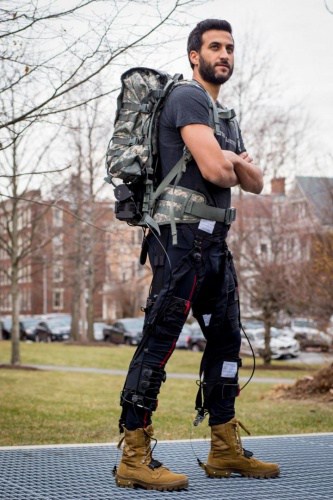
Developed by a team at Harvard’s Wyss Institute for Biologically Inspired Engineering and the university’s John A Paulson School of Engineering and Applied Sciences (SEAS), the suit aids the user through the application of mechanical forces at multiple joints. Textile components worn at the thighs and calves are powered via cables controlled by a mobile actuation unit that fits around the waist and can be integrated with a military rucksack.
"We have updated all components in this new version of the multi-joint soft exosuit,” said David Perry, a co-author of a study on the suit that was presented at the 2018 IEEE International Conference on Robotics and Automation (ICRA). “The apparel is more user-friendly, easy to put on and accommodating to different body shapes; the actuation is more robust, lighter, quieter and smaller; and the control system allows us to apply forces to hips and ankles more robustly and consistently."
Exosuits have long been investigated for military purposes, as they could allow soldiers to trek long distances and arrive at their destination less fatigued. As a result, the exosuit project was funded by the Defence Advanced Research Projects Agency (DARPA) as part of its Warrior Web programme. The Harvard team had previously demonstrated the benefits of the soft robotic device in the lab, but a new study, published in the Journal of NeuroEngineering and Rehabilitation (JNER), has demonstrated that the results can be replicated in the field.
The suit was tested by seven soldiers on a 12-mile cross-country hike in Maryland and a new tuning method was applied that optimised the actuation forces based each individual’s gait. According to the team, the technique can also be used as a proxy measure for elaborate energy measurements.
"We evaluated the metabolic parameters in the seven study participants wearing exosuits that underwent the tuning process and found that the method reduced the metabolic cost of walking by about 14.8 per cent compared to walking without the device and by about 22 cent compared to walking with the device unpowered," said Sangjun Lee, the first author of both studies and a graduate student at SEAS.
The researchers believe that the tuning process is a significant step forward in the optimisation of soft exosuits and could help unlock benefits for people who previously gained little assistance from the technology.




Project to investigate hybrid approach to titanium manufacturing
What is this a hybrid of? Superplastic forming tends to be performed slowly as otherwise the behaviour is the hot creep that typifies hot...